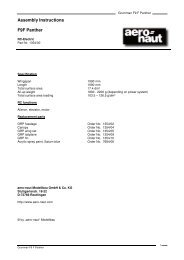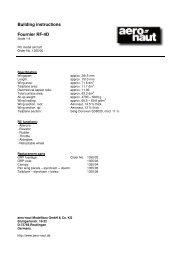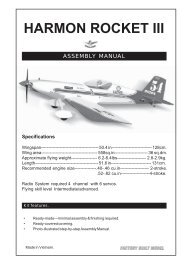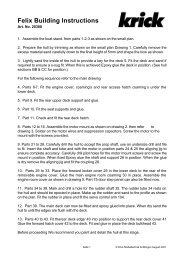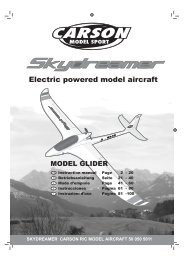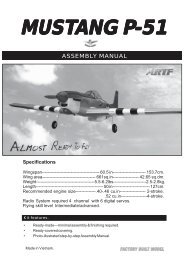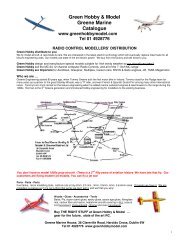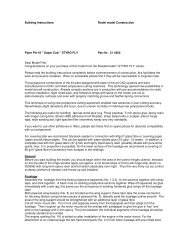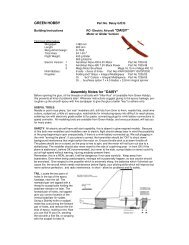Download Manual for Aero-naut Buecker Jungmeister 133
Download Manual for Aero-naut Buecker Jungmeister 133
Download Manual for Aero-naut Buecker Jungmeister 133
- No tags were found...
You also want an ePaper? Increase the reach of your titles
YUMPU automatically turns print PDFs into web optimized ePapers that Google loves.
Bücker <strong>133</strong> <strong>Jungmeister</strong>die-cut parts are to be installed. Remove rough edges from the fin and tailplane slots, the bowdencable exit slots and the cockpit opening using a high-speed diamond cutter. Rub down the wholefuselage and cowl using 400-grit wet-and-dry paper, used wet, to ensure that the final painted finishadheres really well.Glue together the tailskid mount (21), the motor bulkhead (4+5), the tail post (3) and the wing retainerplates (19) in pairs, using laminating resin to produce really strong joints. When the resin has cured,glue the tailskid mount (21) in the fuselage using thickened laminating resin. When the glue has sethard, apply thickened laminating resin all round the tailskid mount (21) to rein<strong>for</strong>ce the joint. Mix upsome extremely thick resin and apply it between the tailskid mount (21) and the fuselage sides to <strong>for</strong>mfillets. When the resin has cured completely, drill a 2 mm Ø hole through the mount at right-angles tothe fuselage bottom. Assemble the servo mounts, fit the rails (46), and install the servos in the mounts.Drill out the servo output arms to 2 mm Ø to accept the pushrod connectors (74), and install theconnectors. You can now drill the 2 mm Ø hole in parts (44) to accept the bowden cables (28); don’tdo this earlier, as the holes must line up with the pushrod holes in the connectors (74).You will find marked points on the half-<strong>for</strong>mers (26) and (27); these are guide-holes <strong>for</strong> the bowdencables and should be drilled 2 mm Ø. Mark the position of parts (26) and (27) on the fuselage and tackthem in place using cyano, then rein<strong>for</strong>ce the joints with thickened resin. It is best to install the bowdencables (28) and (30) through the fuselage from the rear, threading them through parts (26), (27) and(44). Tack the bowden cables to the fuselage using thin cyano where they project at the tail end, thenapply a fillet of thickened resin on the inside of the fuselage. Tack the receiver aerial tube (30) to thefuselage side using thin cyano, then apply resin at several points to hold it in place. When the resinhas cured, carefully slice off the excess bowden cable outers using a sharp chisel, leaving them flushwith the surface. Glue the already joined wing retainer plates (19) in the fuselage as shown on theplan; use thickened resin and take care to produce strong joints at this important location.Mark the position of the holes <strong>for</strong> the wing dowels (63) on the fuselage as shown on the plan, and drillthem 3 mm Ø. File out the holes to 4 mm Ø, and check that the dowels are an easy, sliding fit, withoutbeing sloppy.Place the bottom wing on the fuselage, align it carefully and tape it in position, so that you can markthe position of the dowels (63) on the wing leading edge working through the holes you have just cut.Cut slots about 8-10 mm wide in the top wing skin at the dowel positions; the correct length is shownon the plan. Cut semi-circular channels in the top of the channeled rail (undercarriage support rail) toaccept the wing dowels - see plan. With the fuselage seated on the wing, check that the dowels arecorrectly located. If everything looks right, apply a little thickened resin to the recesses in thechanneled rail, press the dowels into place from above, position the wing carefully on the fuselage andsecure it again. When the resin has set hard, remove the wing, apply more resin round the dowels intheir seating, and fill the slots with scrap balsa.Fit the wing on the fuselage, align it as accurately as possible, and mark the position of the two holesin the bottom wing centre section (49) on the fuselage, ideally using a 5 mm Ø drill bit. Drill the holesat the marked points using a 4 mm Ø drill, then cut the thread <strong>for</strong> the wing retainer screws using an M5tap. Run a little thin cyano into the tapped holes, allow it to cure completely, then run the tap throughthe holes again to clean up the threads.Drill 4 mm Ø holes in the cabane plates (6), and glue them in the fuselage using thickened resin; theholes in parts (6) must line up with the pilot-drilled holes in the fuselage. When the resin has set hard,file out the holes neatly so that the brass sleeves (7) can be slid easily into place, without requiring<strong>for</strong>ce. Cut two pieces 122 mm long from the brass tube (7). The next step is to roughen the surface ofthe tubes prior to gluing: place the tube on a hard surface, press a sharp, flat file on top and roll it toand fro. De-grease the tubes, tack them in place with a little thin cyano, then apply thickened resin onthe inside of the joints on both sides.Assemble the flight pack cradle and glue the joints with thin cyano be<strong>for</strong>e rein<strong>for</strong>cing them withlaminating resin. Check that the lugs of the battery cradle engage neatly in the slots in the motorbulkhead.The instrument panel (22) should be fixed to the fuselage using Velcro (hook-and-loop) tape so that itcan be removed easily <strong>for</strong> battery replacement.Sand the periphery of the motor bulkhead to match the taper of the fuselage, and drill the holesrequired <strong>for</strong> your selected motor mount. Place the bulkhead in the fuselage, position it as accurately aspossible, and tack it in place with thin cyano. Apply laminating resin all round the periphery to <strong>for</strong>m areally strong joint. We recommend that you rein<strong>for</strong>ce the joint all round with a strip of glass tape about15 - 20 mm wide.Building Instructions Bü-<strong>133</strong> <strong>Jungmeister</strong>5



